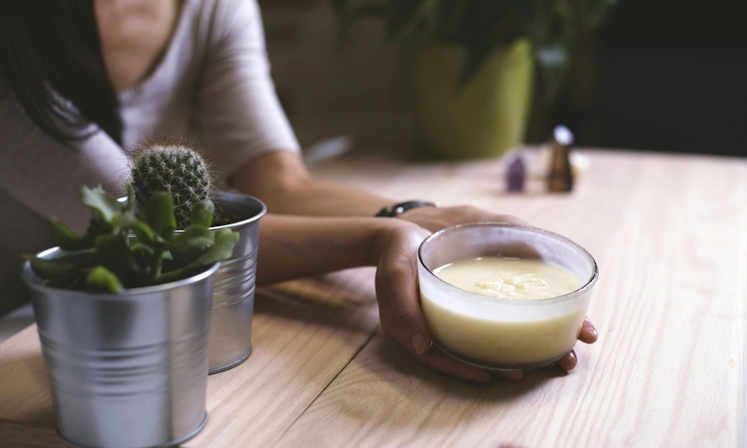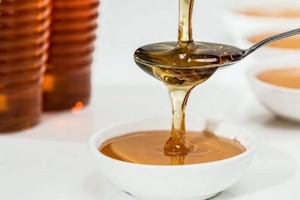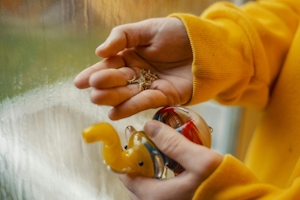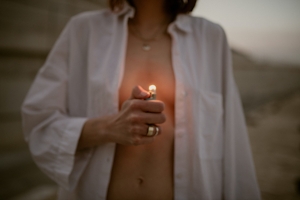
Elsa Olofsson / Unsplash
How To Decarb Weed: The Ultimate Decarboxylation Guide
Looking into how to decarboxylate herbs like cannabis so you can make weed-infused treats.
If you want to make potent cannabis edibles or infuse oils with maximum effects, you can’t skip the science: decarboxylation is the key.
Raw cannabis primarily contains cannabinoid acids, like THCA and CBDA, which aren’t intoxicating until they’re exposed to heat. When done correctly, decarboxylation is a simple but necessary step that converts these acids into active forms like THC and CBD, giving your cannabis products their full therapeutic potential.
The Weed Decarboxylation Process Explained

Odiseo Castrejon / Unsplash
Cannabis decarboxylation is the process that activates the cannabinoids in your weed. The cannabis plant is full of compounds like THCA and CBDA, which aren’t intoxicating. When you heat up cured cannabis buds, a chemical reaction happens: the plant sheds a carboxyl group, releasing carbon dioxide and converting those compounds into the psychoactive THC and CBD. These versions actually interact with your body to produce intoxicating effects.
This isn’t something that only happens when you vape or smoke cannabis. Baking, infusing, or gently heating cannabis also triggers decarboxylation, which is why it’s a crucial step before making edibles, tinctures, or topicals. If you skip it, you’re just working with raw cannabis, and most of the THC will still be locked in its inactive form.
Do You Have to Decarb Weed for Edibles?

To get the most out of your cannabis edibles, decarbing your flower is essential. In its raw state, cannabis won’t give you the same effects because compounds like THCA and CBDA haven’t been converted into their active forms yet.
Applying steady heat unlocks THC and CBD, which are what deliver the experience most people are looking for. While some of this can happen during the infusion process, it’s usually less effective. Decarbing beforehand helps ensure your final product is both potent and consistent.
What's the Best Method of Decarboxylation?

The best way to decarb weed really comes down to how much control you want. Using an oven is convenient, but it’s not always the most reliable. Oven temperatures can swing higher or lower than what the dial says, which makes it easy to overheat or under-decarb your flower.
If you’re looking for more precision, methods like sous vide or placing your cannabis in a sealed jar work better. They maintain a steady temperature and help protect delicate cannabinoids and terpenes from breaking down, resulting in more consistent results and better flavor retention.
How to Decarb Weed in an Oven the Right Way

Decarboxylating weed in an oven gives you control over the heat and timing needed to activate cannabinoids, though some cannabis terpene loss is expected due to the heat. Here’s how to do it right while minimizing what you lose.
Materials:
- Ground cannabis flower (medium consistency)
- Baking sheet
- Foil or parchment paper
- Oven thermometer
- Sealed jar or container
Preparation, Temperature, Timing:
Before heating cannabis, you’ll need to prep it properly:
- Should weed be ground? Yes, grinding your week promotes even heat distribution during decarboxylation. It’s ideal to use a weed grinder for an even grind.
- Oven temperature: Aim for a decarboxylation temperature between 104°C (220°F) and 116°C (240°F). Use an oven thermometer to verify actual oven temperature, since oven dials aren’t always accurate. A few degrees too hot or too cool can alter your results.
- How long to decarb weed: Bake cannabis at 230°F for about 40 minutes. If you’re decarbing for high-CBD cannabis, extend the time to 60 minutes to fully activate CBDA into CBD.
Directions
Step 1: Preheat the Oven
Set your oven to 230°F (110°C). Use an oven thermometer to confirm accuracy.
Step 2: Prepare Cannabis
Line a baking sheet with parchment paper or foil. Evenly spread the broken-up cannabis flower across the sheet.
Step 3: Bake
Place the baking sheet on the middle rack and bake for 40 minutes. Mix gently halfway through to ensure even decarboxylation.
Step 4: Cool and Store
Let the decarboxylated cannabis cool completely before transferring it to an airtight container. It should be light golden brown and crumbly, not too dark or burnt.
Decarbing Weed Without an Oven

If you don’t have access to an oven, you can still decarb weed at home using a few alternative methods. Each approach comes with its pros and cons, but with a bit of care, you can still activate cannabinoids effectively.
Crockpot (Slow Cooker) Method
The crockpot method is slow but easy, and it works well if you’re not in a rush. You’ll want to break up your cannabis flower and place it in a mason jar with the lid resting loosely on top. Fill your crockpot with enough water to come about halfway up the sides of the jar, then set the temperature to low. Let the jar sit in the warm bath for a few hours; four is usually a good target. Gently tip or rotate it once or twice along the way. When you’re done, pull the jar out carefully and allow it to cool before opening.
Once you’re done decarboxylating, check out our guide on Making Cannabis Oil in a Crockpot.
Glass Jar in a Pot
If you don’t have an oven, a mason jar and a pot of water can still get the job done. Just break up some cannabis and toss it into the jar, don’t pack it too tight, and don’t seal the lid all the way. Warm a pot of water until it’s barely simmering, then gently set the jar in it. You’ll want it sitting upright, not floating or tipping over. Let it sit in the hot water for about an hour and a half. After that, pull it out carefully and give it time to cool off before cracking it open. It’s not the fastest method, but it’s a solid option for anyone trying to preserve more flavor and potency.
Microwave
Microwaving cannabis to decarb it isn’t ideal, but it can work when you’re short on time and options. It’s hard to control the heat evenly, which means the cannabinoids and terpenes can burn off pretty easily. If you’re going to try it, use a microwave-safe dish and start with cannabis that’s been broken up slightly, not ground too fine. Heat it on a medium setting for about a minute and a half, then give it a break to cool down slightly. Check how it looks and smells; it should be slightly toasted but not scorched. If needed, you can give it another short burst, but be careful not to overdo it.
Vacuum Bag in Water Bath (Sous Vide)
Sous vide is one of the most precise options for decarbing weed without an oven. Seal your cannabis flower in a vacuum bag and submerge it in a water bath heated to 203°F (95°C). Let it decarb for about 90 minutes. When finished, remove the bag and allow it to cool completely before using your decarboxylated cannabis.
Already Vaped Bud (AVB)
If you’ve been vaporizing cannabis with a dry herb device, don’t toss the leftover flower. Known as already vaped bud, or AVB, this material has already gone through the decarboxylation process.
While vaporizing doesn’t extract every compound from the plant, it activates a significant portion of the cannabinoids present, especially THC, leaving behind flower that’s less potent but still very usable. AVB can be infused into oil or butter, added to capsules, or mixed directly into food. The flavor leans roasted and earthy, but it’s an easy way to get more out of your cannabis without wasting anything.
How to Use Your Decarbed Weed

Once your cannabis flower has been properly decarboxylated, it’s ready for just about any infusion or formulation you want to create.
Decarbed cannabis typically gets infused into a fat-based carrier, such as coconut oil, olive oil, or butter (also known as cannabutter). These fats bind well with cannabinoids, making them ideal for making cannabis edibles, topicals, or tinctures. Cannabis-infused oils can then be easily used in recipes for baked goods, sauces, dressings, or even savory meals.
You can also use decarboxylated cannabis directly in recipes if the food includes a fat source to help with absorption. Think peanut butter, chocolate, or anything oil-based. While you won’t get the same precise dosing as you would with a lab-tested extract, you’ll still feel the effects if your cannabis has been properly decarbed and infused.
Some consumers choose to pack decarboxylated weed into capsules for easy ingestion, especially those using cannabis for chronic pain regularly or other therapeutic benefits. Others prefer using it to make their own tinctures, either alcohol- or oil-based, which can be taken sublingually or added to beverages.
If you’re working with cannabis topicals, infused cannabis oils can be infused into salves or lotions to target localized pain and inflammation. While these won’t produce psychoactive effects, they can still deliver the therapeutic properties of cannabinoids and terpenes when applied to the skin.
Regardless of how you choose to use it, ensure that you store your decarboxylated weed in an airtight container in a cool, dark place. This helps preserve its potency, flavor, and cannabinoid profile until you’re ready to infuse or consume it.
Most Reliable THCA Flower for Making Edibles
When decarboxylating flower for edibles, you’ll want to choose flower that’s guaranteed to hold its quality and potency through the heating process. Bloomz’s THCA Hemp Flower decarboxylates reliably and maintains its stickiness and flavor throughout the process.
THCA is the precursor to delta-9 THC, meaning THCA becomes delta-9 THC (the typical THC most users are familiar with) when heated. Once decarboxylated, THCA flower essentially becomes THC flower. Available in 3.5g, 7g, and 28g options, Bloomz THCA Hemp Flower is available in various strains, such as:
- Animal Mints
- Gary Payton
- Girl Scout Cookies
- Ice Cream Cake
- Tropicanna Cherries
FAQ

Correen / Unsplash
What does decarbed weed look like?
It should be dry, crumbly, and golden to light brown in color.
Can you decarb weed too long?
Yes, excessive heat or baking time can destroy cannabinoids and terpenes, reducing potency and flavor.
Can you decarb weed without any smell?
Not entirely, but methods like sous vide or sealed jars reduce odor compared to open-oven decarbing.
Can you decarb weed in a skillet?
You can, but it’s hard to control the heat evenly. There’s a high risk of burning and losing cannabinoids.
Can weed decarb in a hot car?
Not effectively. It won’t reach consistent or high enough temperatures to complete the decarboxylation process safely.
Does decarboxylation destroy CBD?
No, but overheating can cause it to degrade. Slow, low heat helps preserve cannabinoids, such as CBD.
At what temperature do terpenes evaporate?
Many terpenes begin to evaporate around 250°F (121°C), so keep decarbing temps lower to preserve them.
Herb Recommended Products:
READ MORE











